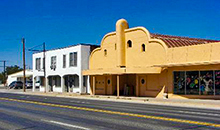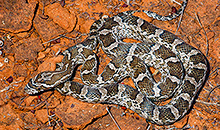Main Menu
Reagan County Data
Reagan County Communities & Places
Genealogy & History Links by USGHN
Important Reagan County Addresses
Sponsors
Reagan County Neighbors
Crockett County, Texas
Glasscock County, Texas
Irion County, Texas
Midland County, Texas
Sterling County, Texas
Tom Green County, Texas
Upton County, Texas
Other Websites
Welcome to Reagan County Texas Genealogy & History Network!
Welcome to the Reagan County, Texas Genealogy & History Network. Our purpose is to provide visitors with free resources for genealogical and historical research. To share your genealogy or history information, send an email to txghn@outlook.com and we will happily include it here. For other Texas Counties, visit the Texas Genealogy & History Network state website and go to the appropriate county. Thanks for visiting and good luck with your research! |
|
About Reagan County, Texas...

Reagan County is in West Texas at the northwestern edge of the Edwards Plateau. Big Lake, the county seat, is seventy miles southwest of San Angelo.
Though early inhabitants remain undocumented, it is likely that Paleo-Indians lived on the land that became Reagan County. Spanish expeditions probably traversed the area; local Jumano Indians encouraged the Spanish to establish missions there on several occasions in the seventeenth century. Kiowa and Comanche Indians used the area as a hunting ground and later raided local ranches, but it remained largely unsettled country until the nineteenth century.
An important source of water for prehistoric peoples and early travelers was Grierson Springs, which once flowed substantially in southwestern Reagan County. Spaniards probably discovered the springs in January 1684, when the expedition of Juan Domínguez de Mendoza arrived there and camped for two days. The Comanches also used the springs as a campsite. In 1858 the Butterfield Overland Mail missed  the springs when planners drew its stage route along Centralia Draw across the center of the county, but a source of fresh water was the first consideration when an outpost for Fort Concho was selected on April 30, 1878.
the springs when planners drew its stage route along Centralia Draw across the center of the county, but a source of fresh water was the first consideration when an outpost for Fort Concho was selected on April 30, 1878.
Both the springs and the camp were named in honor of Col. Benjamin H. Grierson, who located the camp at the site. Camp Grierson was part of the army's plan to protect white society in the area from Indian attack and ultimately to eliminate the Indians from Texas. The camp was abandoned in 1882 when Grierson and his Tenth Cavalry were transferred from Fort Concho to Fort Davis.
On May 26, 1885, George W. Wedemeyer stopped at the springs and described the camp as in ruins. P. H. Coates, whose family arrived in a train of seventeen wagons in 1885, also camped at the springs. By the 1890s sheep and goat ranchers had moved into the central area of the county near the homesite of another early settler, Gordon Stiles, on Centralia Draw. The local post office, named for Stiles, was established in 1894, and a store opened there before 1900.
 Reagan County was carved from Tom Green County in 1903 and named for Senator John H. Reagan, the first chairman of the Railroad Commission. Stiles became the first county seat. After constructing two temporary frame courthouses, county officials built a striking two-story white stone building in 1911. A wooden school building was constructed adjacent to the courthouse. Early in the twentieth century post offices opened at two other small communities in Reagan County. Reaganview, fifteen miles northeast of Stiles, operated a post office from 1905 through 1910 and a one-teacher school from 1902 to 1915. The second community, Isaac, maintained a post office from 1907 through 1909. In 1905 the P. H. Coates family settled in southern Reagan County on the west side of Big Lake.
Reagan County was carved from Tom Green County in 1903 and named for Senator John H. Reagan, the first chairman of the Railroad Commission. Stiles became the first county seat. After constructing two temporary frame courthouses, county officials built a striking two-story white stone building in 1911. A wooden school building was constructed adjacent to the courthouse. Early in the twentieth century post offices opened at two other small communities in Reagan County. Reaganview, fifteen miles northeast of Stiles, operated a post office from 1905 through 1910 and a one-teacher school from 1902 to 1915. The second community, Isaac, maintained a post office from 1907 through 1909. In 1905 the P. H. Coates family settled in southern Reagan County on the west side of Big Lake.
The railroad chose a route through Big Lake rather than Stiles, because a large landowner near Stiles failed to grant a right-of-way. A post office, public school, newspaper office, and various stores were established by 1912. In 1913 a Methodist church was formed, and in 1915 a Baptist church was organized with fifteen members. A red brick ten-grade school opened, and the Big Lake Hotel was completed in 1915.
 In May 1923 the focus of the area economy changed from agriculture to petroleum when the Big Lake oilfield started producing. The discovery opened the Permian Basin and all of West Texas to oil exploration and production. By summer oil leases sold for quick profits to local landowners and out-of-town speculators. Several cafes, a hardware store, a lumberyard, and other new businesses opened to serve the expected Big Lake boom, and the local hotel was expanded by a twelve-room addition. Big Lake citizens voted to incorporate on August 15, 1923. In 1925, by which time the population had reached 100 and Big Lake appeared to be the most important town in the county, voters moved the seat of government there from Stiles.
In May 1923 the focus of the area economy changed from agriculture to petroleum when the Big Lake oilfield started producing. The discovery opened the Permian Basin and all of West Texas to oil exploration and production. By summer oil leases sold for quick profits to local landowners and out-of-town speculators. Several cafes, a hardware store, a lumberyard, and other new businesses opened to serve the expected Big Lake boom, and the local hotel was expanded by a twelve-room addition. Big Lake citizens voted to incorporate on August 15, 1923. In 1925, by which time the population had reached 100 and Big Lake appeared to be the most important town in the county, voters moved the seat of government there from Stiles.
The community of Best, six miles from the discovery well, received a post office in 1924 and operated a grade school under an emergency permit. Best developed into a typical 1920s boom town with growing vice and violence, reaching a population estimated at 3,000 by 1925. In an effort to clean up the town, citizens called out the Texas Rangers, who destroyed buildings that were being used as brothels, gambling houses, and saloons. Between 1923 and 1973 the county produced over 287 million barrels of oil.
 The county has a total area of 1,176 square miles, of which 1,175 square miles is land and 1 square mile (0.08%) is water. The population recorded in the 1910 Federal Census was 392. The population peaked in 1990 at 4,514. The 2010 census recorded 3,367 residents in the county.
The county has a total area of 1,176 square miles, of which 1,175 square miles is land and 1 square mile (0.08%) is water. The population recorded in the 1910 Federal Census was 392. The population peaked in 1990 at 4,514. The 2010 census recorded 3,367 residents in the county.
Neighboring counties are Glasscock County (north), Sterling County (northeast), Tom Green County (east), Irion County (east), Crockett County (south), Upton County (west), and Midland County (northwest). The county seat is Big Lake. Other communities in the county include Best, Texon, and Stilesm.
Reagan County, Texas Records
Birth Records - The Texas Department of State Health Services has records from 1903 to present. Records for the last 75 years considered private and will only be provided to certain individuals. To obtain current information on who may obtain a record, how to submit a request and an official request form, see the Texas Department of State Health Services website or write to Texas Vital Records, Department of State Health Services, P.O. Box 12040, Austin, TX 78711-2040.
For older birth records you will have to write to the County Clerk of the applicable county. The existence of birth records prior to 1903 will vary widely from county to county. Local historical societies and genealogy collections in local libraries may be able to provide some information.
Death Records - The Texas Department of State Health Services has records from 1903 to present. Records for the last 25 years considered private and will only be provided to certain individuals. To obtain current information on who may obtain a record, how to submit a request and an official request form, see the Texas Department of State Health Services website or write to Texas Vital Records, Department of State Health Services, P.O. Box 12040, Austin, TX 78711-2040.
Marriage Records - The Texas Department of State Health Services can provide a verification letter of marriage for Texas marriages from 1966 to present. This is NOT a marriage license. To obtain a certified copy of a marriage license you must contact the County or District Clerk in the county or district where the marriage took place.
Local historical societies and genealogy collections in local libraries may be able to provide some information.
Divorce Records - The Texas Department of State Health Services can provide a verification letter of divorce for Texas divorces from 1968 to present. This is NOT a copy of the divorce decree. To obtain a certified copy of a copy of the divorce decree you must contact the County or District Clerk in the county or district where the divorce took place.
Local historical societies and genealogy collections in local libraries may be able to provide some information.




